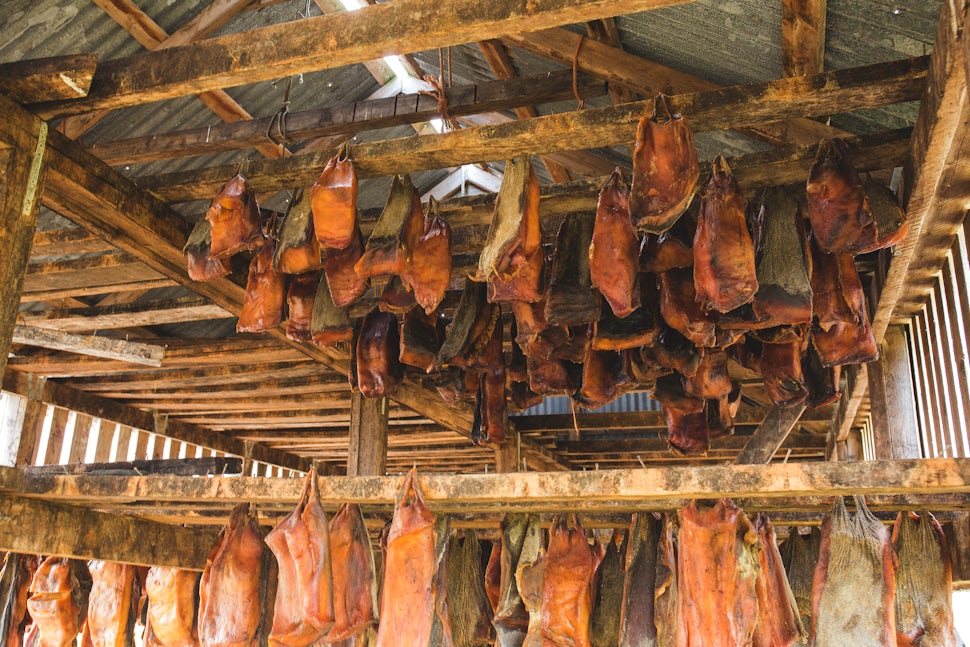Hákarl, Iceland's Fermented Shark, the "World's Most Disgusting Food"
One of the wolds most bizarre and appalling foods in one of it's most beautiful and remote places.

As a wanderer and traveler one understand the fact that the unique and inspiring qualities of traveling are not only the beautiful landscapes but also the cultural experiences. In Iceland, a world once-removed from the rest of Europe, those cultural traditions were born of isolation and hardship alone on a volcanic mars like landscape in the middle of the North Atlantic. Here the beautiful, unique, and hardy people found solutions to cold desolate winters, taking what they could from the sea and scraping together what was left on land.
One of the most unique of those solutions came in the form of drying and fermenting the otherwise poisonous Greenland Shark. This species of shark is the most cold tolerant shark on the planet, often swimming to great depths and staying at those depths for long periods of time. A native of the cold North Atlantic the Greenland Shark averages 15ft in length a formidable opponent in size to its cousin the Great White. A deep water species this shark was primarily used by early fisherman for it's liver and the oils it contained, enabling Icelanders to have both heat and light during their long winters. As well, the oils became a valuable trade commodity with the rest of Europe until the early 1900's.
Originally caught by a fleet of well-worn fisherman in small row boats, the behemoths became a local delicacy as food stuffs ran out and large carcases were left unutilized. Along the remote northern coast of Iceland's Snæfellsnes Peninsula, you can understand the isolation that led to the discovery and cultivation of such a tradition as hunting and ultimately consuming an otherwise poisonous species. Somewhere along Iceland's Hwy 54 heading east among a field of lava covered by otherworldly green, a single metal etched statue of a Greenland Shark appears on the side of a road which seems to drive further into the lava expanse without an end in site. The lonely sign meant to denote one of the most famous of the Greenland Shark fishing families farms in Iceland. Here in a small converted barn the Bjarnarhöfn Shark Museum celebrates the tradition of Greenland Shark fishing that has persisted for generations. As you walk around, reviewing the boats, classic and contemporary tactics for catching and consuming the shark you ultimately find yourself walking a short ways to the open air drying shed on the back of the property. Here you get a glimpse into the process of turning the ammonia ridden shark carcass into an edible (some say) delicacy.
The process after the shark is caught is to cut the shark into aprox 5-10lbs strips. The carcass containing enough ammonia to make one very sick, Icelanders realized that the best way to create consumable shark was to leave it to ferment in the open air for 4-6 months, tacked to the rafters of an open shad. The process causes the shark flesh to breakdown and as the shark dries some of the ammonia is released. Sadly, for those of us with a sense of adventure this means it becomes edible. After months outside the flesh is cut into small cubes and consumed with a shot of a local caraway-seed liquor called Brennivín. A mouthfeel similar to cheese and soft day old fish combined with a scent of ammonia which will cause your eyes to water, the food has often been referred to as one of the worlds worst.
Needless to say, the adventure along the north Snæfellsnes Peninsula coast as well as the exploration of the local tradition is unlike any I have had before. Taking a turn into the remote lava field and finding your way to Bjarnarhöfn Shark Museum is an adventure well worth its weight in smelly fish.
Follow Connor and his Adventures on his Website, Instagram and Tumblr .
We want to acknowledge and thank the past, present, and future generations of all Native Nations and Indigenous Peoples whose ancestral lands we travel, explore, and play on. Always practice Leave No Trace ethics on your adventures and follow local regulations. Please explore responsibly!
Do you love the outdoors?
Yep, us too. That's why we send you the best local adventures, stories, and expert advice, right to your inbox.








